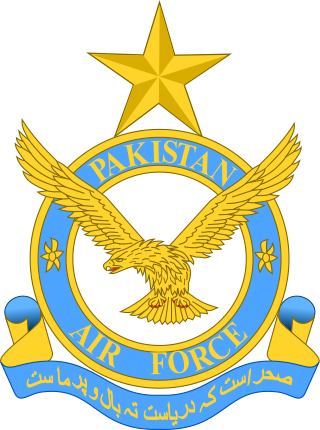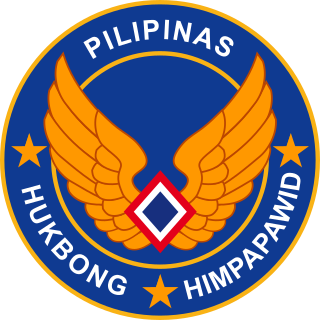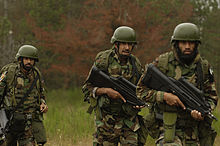
The Pakistan Armed Forces are the military forces of Pakistan. It is the world's sixth-largest military measured by active military personnel and consist of three formally uniformed services—the Army, Navy, and the Air Force, which are backed by several paramilitary forces such as the National Guard and the Civil Armed Forces. A critical component to the armed forces' structure is the Strategic Plans Division Force, which is responsible for the maintenance and safeguarding of Pakistan's tactical and strategic nuclear weapons stockpile and assets. The President of Pakistan is the Commander-in-Chief of the Pakistan Armed Forces and the chain of command is organized under the Chairman of the Joint Chiefs of Staff Committee (JCSC) alongside the respective Chiefs of staffs of the Army, Navy, and Air Force. All branches are systemically coordinated during joint operations and missions under the Joint Staff Headquarters (JSHQ).

The Pakistan Air Force (PAF) is the aerial warfare branch of the Pakistan Armed Forces, tasked primarily with the aerial defence of Pakistan, with a secondary role of providing air support to the Pakistan Army and Navy when required, and a tertiary role of providing strategic airlift capability to Pakistan. As of 2021, as per the International Institute for Strategic Studies, the PAF has more than 70,000 active-duty personnel and operates at least 1370+ aircraft.PAF stands as the eight largest Air Force in the world while holds the title of being largest Air Force of the Muslim World in terms of aircraft fleet. Its primary mandate and mission is "to provide, in synergy with other inter-services, the most efficient, assured and cost effective aerial defence of Pakistan." Since its establishment in 1947, the PAF has been involved in various combat operations, providing aerial support to the operations and relief efforts of the Pakistani military. Under Article 243, the Constitution of Pakistan appoints the President of Pakistan as the civilian Commander-in-Chief of the Pakistan Armed Forces. The Chief of the Air Staff (CAS), by statute a four-star air officer, is appointed by the President with the consultation and confirmation needed from the Prime Minister of Pakistan.
United States special operations forces (SOF) are the active and reserve component forces of the United States Army, Marine Corps, Navy and Air Force, as designated by the Secretary of Defense and specifically organized, trained, and equipped to conduct and support special operations. All active and reserve special operations forces are assigned to the United States Special Operations Command (USSOCOM).

The Norwegian Armed Forces is the military organization responsible for the defence of Norway. It consists of five branches, the Norwegian Army, the Royal Norwegian Navy, which includes the Coast Guard, the Royal Norwegian Air Force, the Home Guard, and Norwegian Cyber Defence Force as well as several joint departments.

The Military Freefall Parachutist Badge is a military badge of the United States Army and United States Air Force awarded to qualified U.S. Army and U.S. Air Force personnel as high-altitude military parachute specialists.

The Parachutist Badge, also commonly referred to as "Jump Wings", is a military badge of the United States Armed Forces. Some services, such as the Marine Corps, officially refer to it as an insignia instead of a badge. The United States Space Force and United States Coast Guard are the only branches that do not award the Parachutist Badge, but their members are authorized to receive the Parachutist Badges of other services in accordance with their prescribed requirements. The DoD military services are all awarded the same Military Parachutist Badge. The U.S. Army and U.S. Air Force issue the same Senior and Master Parachutist Badges while the U.S. Navy and U.S. Marine Corps issue the Navy and Marine Corps Parachutist Insignia to advanced parachutists. The majority of the services earn their Military Parachutist Badge through the U.S. Army Airborne School.

The Kopaska is the premier frogman and underwater demolition unit of the Indonesian Navy. The unit's motto is in Sanskrit: Tan Hana Wighna Tan Sirna. The unit's main duties are underwater demolition, destroying main underwater installations, reconnaissance, prisoner snatches, preparing beaches for larger naval amphibious operations, and counter-terrorism. During peacetime, the unit also deploys a team to serve as security personnel for VIPs and VVIPs. The personnel of Kopaska are recruited from Indonesian Navy seamen. Like other Indonesian special forces, Kopaska is trained to be able to conduct operations in the sea, including underwater, on land and airborne.

The Commandement des Opérations Spéciales or COS is a joint staff charged with overseeing the various special forces of the French Army, Navy and Air and Space Force, bringing them all under a single operational authority. The command is placed under the orders of the Chief of Defence Staff and under the direct authority of the President of the French Republic.

Special Reconnaissance (SR)—formerly Special Operations Weather Technician or Team (SOWT)—is conducted by trained Air Force personnel assigned to Special Tactics Squadrons of the United States Air Force Special Operations Command who operate deep behind enemy lines to conduct covert direction of air and missile attacks, place remotely monitored sensors, and support other special operation units. Like other special operations units, SR units may also carry out direct action (DA) and unconventional warfare (UW), including guerrilla operations. As SOWTs they were tactical observer/forecasters with ground combat capabilities and fell under the Air Force Special Tactics within the Air Force Special Operations Command (AFSOC). The mission of a Special Operations Weather Technician was to deploy by the most feasible means available into combat and non-permissive environments to collect and interpret meteorological data and provide air and ground forces commanders with timely, accurate intelligence. They collect data, assist mission planning, generate accurate and mission-tailored target and route forecasts in support of global special operations, conduct special weather reconnaissance and train foreign national forces. SOWTs provided vital intelligence and deployed with joint air and ground forces in support of direct action, counter-terrorism, foreign internal defense, humanitarian assistance, special reconnaissance, austere airfield, and combat search and rescue.
East Pakistan Air Operations covers the activity of the Pakistan Air Force (PAF) and Pakistan Army Aviation units in former East Pakistan during the Bangladesh Liberation War. The operations involved the interdiction, air defense, ground support, and logistics missions flown by the Bangladesh Air Force, Indian Air Force, and the Indian Navy Aviation wing in support of the Mukti Bahini and later Indian Army in Bengal.
The 323rd Parachute Ranger Squadron or Fallskärmsjägarna is a Swedish military special operations capable airborne ranger unit specialising in long-range reconnaissance.

The maroon beret in a military configuration has been an international symbol of airborne forces since the Second World War. It was first officially introduced by the British Army in 1942, at the direction of Major-General Frederick "Boy" Browning, commander of the British 1st Airborne Division. It was first worn by the Parachute Regiment in action in North Africa during November 1942.

The Pakistan Navy Special Service Group, abbreviated SSGN or simply Pakistan Navy SEALs, is the special operations force tasked with the conducting the small-unit based military operations in all environmental formats of the sea, air, and land by adopting to the tactics of the unconventional warfare.

Special reconnaissance (SR) is conducted by small units, such as a recon team, made up of highly trained military personnel, usually from special forces units and/or military intelligence organizations. Special reconnaissance teams operate behind enemy lines, avoiding direct combat and detection by the enemy. As a role, SR is distinct from commando operations, but both are often carried out by the same units. The SR role frequently includes covert direction of airstrikes and indirect fire, in areas deep behind enemy lines, placement of remotely monitored sensors, and preparations for other special forces. Like other special forces, SR units may also carry out direct action and unconventional warfare, including guerrilla operations.

The Philippine Air Force (PAF) is the aerial warfare service branch of the Armed Forces of the Philippines. Initially formed as part of the Philippine Army, the PAF is responsible for both defending the Philippine airspace, and conducting aerial operations throughout the Philippines, such as close air support operations, combat air patrols, aerial reconnaissance missions, airlift operations, helicopter tactical operations and aerial humanitarian operations. The PAF is headquartered at the Villamor Air Base in Pasay, and is headed by the Chief of the Air Force, who also serves as the branch's highest-ranking military officer.

The Pakistan Army Special Service Group or SSG is the special forces unit of the Pakistan Army. They are also known by their nickname of "Maroon Berets" due to their headgear.
Military exercises are conducted by the Pakistan Armed Forces to increase combat readiness, and to identify problems in logistics, training, and current military doctrine. They also test the ability of units to work together. Lastly, they act as a visible expression of military might, which acts as a deterrent to potential enemy action. An important component of each exercise is the after-action assessment. Since 1989 the four branches services have increasingly begun coordinated exercises.
The 21st Special Service Group is a command for Malaysian Army special forces, the Gerak Khas. The 21 SSG and 10th Parachute Brigade are elite fighting formations of the Malaysian Army. Both units are independent units under the Malaysian Army and report directly to the Chief of Army. The headquarters of the 21 SSG are at Iskandar Camp in Mersing, Johor.

















